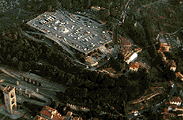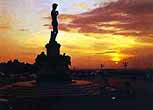
Piazzale Michelangelo from the air
You can reach Piazzale Michelangelo and the Basilica of San
Miniato on Monte alle Croci on foot by taking the wonderful spectacular
route that architect Giuseppe Poggi created between 1865 and 1871, during
the period in which Florence was the capital city of the Kingdom of Italy.
Poggi's design also included the continuation of the main circular boulevards
up into the hills to the south of the city, which he carried out by knocking
down what was left of the third circle of city walls of Florence, built between
1284 and 1333. Only a few of the ancient Porte or Gates into the city were saved
from demolishment (Porta Romana, Porta al Prato, Porta a San Gallo, Porta a Santa
Croce, Porta della Zecca Vecchia and Porta a San Niccolò); Poggi allowed
them to remain in the centre of the squares he was creating along the boulevards,
where they can still be seen to this day.

Florence from Piazzale Michelangelo
The walk up to Piazzale Michelangelo starts out from Porta a San Niccolò
(Piazza Poggi), the only gate whose original high tower of defence
(1324) is still complete. Two small neo-sixteenth century palaces,
built by Poggi to close off Via San Niccolò, stand opposite
it. The first part of the pedestrian ramp that leads up to Piazzale
Michelangelo and then on to the church courtyard of San
Miniato is situated in the centre.
The Piazzale itself overlooks one of the most famous and magnificent city views
in the world: from here you can see the whole of Florence at a glance, from Forte
Belvedere to Santa Croce, the Ponte Vecchio, the Duomo,
the Uffizi, Palazzo della Signoria and the Bargello,
etc. Higher up, on the other side of Florence, you can see the hills to the north,
with Fiesole and the tall belltower of its Cathedral (1213) standing out in their
midst.

The copy of the David
The square takes its name from the great bronze group that Poggi placed
in its centre, a real "pastiche" of the work of Michelangelo, composed of copies of his David
(now in the Academy Museum) and the four allegorical
figures Pope Clement VII commissioned him to carry out for the Medici
tombs in the New Sacristy in San Lorenzo (these were for the tombs of
Lorenzo Duke of Urbino and Giuliano Duke of Nemours).
Poggi also designed the Loggia which can be seen tucked into the hill behind
the sculptures; his idea of using it as a museum to contain all the works
of Michelangelo came to nothing; today it is just a coffee bar and restaurant.
If you carry on up the hill, you will come to some steps beside the La Loggia
restaurant that lead up to the church of San Salvatore (or San Francesco) at
Monte alle Croci, which Michelangelo rebaptized the "lovely little villa".
This important Renaissance building is still where most Florentines prefer to
go for Midnight Mass on Christmas Eve; it was almost completely rebuilt over
the pre-existent oratory of San Damiano by architect Simone del Pollaiolo, known
as Il Cronaca (1499-1504), who was given the commission by the Franciscan monks
and the extremely powerful Arte di Calimala, the guild of merchants of woollen
cloth and the creators of the wealth of the city so many centuries before.
The facade is both austere and graceful and designed with alternating curved
and triangular tympani, like the Baptistery. The interior, with its tauter rythm
and the chiaroscuro division created by the two upper orders, shows signs of
an attempt to get away from the influence of Brunelleschi.
The Deposition attributed to Giovanni Della Robbia and
the Pietà attributed to Neri di Bicci are of particular interest.
